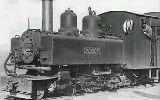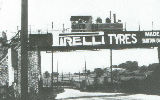Railways
With thanks to Cliff Williams for use of the photographs and
facts
Well there is still a main line railway existing in Clay Cross, the main
Leeds to Derby line which runs underneath the town and the Sheffield to
Nottingham (Erewash) line which runs to the east of the town. Clay Cross station
was actually situated in the township of Tupton, 2 miles from Clay Cross and the ticket
entitled the bearer to right to walk along the embankment to the town. There was
a goods station in the town terminating on Market Street, part of this line ran
up to the works for the movement by rail of goods in and pipes out. Originally
the goods out was coal from the Numbers 1, 2 and 3 pits which was then
taken as far as London.
The other 'railway' was the narrow gauge Ashover Light Railway (ALR). Detail
about this railway can be found at
Ashover Light
Railway. Primarily, this was constructed to carry lime from Ashover to the ovens at the
Clay Cross Works
There were 5 steam locomotives used on the ALR, which were Baldwin's and named after
General Jackson's daughters and sons. Bridget (Elizabeth Bridget Huth Jackson),
Joan (Hermina Joan Carmichael Jackson), Hummy (Henry Humphry Jackson) and Guy
(Guy Rolf Jackson). The daughter known as Peggy was in fact Margaret Beatrice
Meinertzhagen Jackson.
The Ashover Light Railway Society plan to reopen a section of this railway and hope to see steam trains working again on it.
The Station
Clay Cross railway station was built by the North Midland Railway in 1840. It
was originally planned to have been built within the Clay Cross Tunnel, however
it was clear that it would be impossible to ventilate it effectively, so instead
it was built at the northern entrance
The original station was by Francis Thompson in the Italianate design. In 1879
the line from the Midland Counties Railway was built through the Erewash Valley
meeting the North Midland at the station, which had platforms serving two
passenger lines, with two goods lines passing to the east, which continued the
whole way down the Erewash Valley. The station was rebuilt by the Midland
Railway and enlarged to serve four tracks, with two outer platforms and an
island platform in the middle.
The station was closed in 1967.
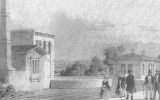 |
|
 |
|
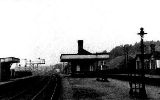 |
|
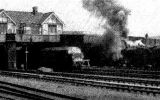 |
Original station |
|
looking south |
|
looking north |
|
from the embankment |
The Tunnel
Clay Cross Tunnel is 1784-yard long on the former North Midland Railway line.
It begins at the highest point of the line, just after the old Stretton railway
station. Situated at the watershed of the rivers Amber and Rother, it was
completed by George Stephenson in 1839.
Clay Cross is directly above it and there are ventilation shafts in Market
Street and High Street (some 144 feet above the line) and also in Clay Lane and
Bridge Street.
Until the building of the tunnel, no deep prospecting for minerals had been
carried out. The discovery of coal and iron led to George Stephenson with a
group of others, buying a tract of land south of the tunnel and set up a
company, George Stephenson and Co., later renamed the Clay Cross Company.
Nevertheless the boring of the tunnel was not straightforward, eventually
costing £140,000 instead of the expected £98,000, with the loss of fifteen
lives.
The northern portal is a magnificent Moorish design and is now a grade 2 listed
building.
The tunnel saw one of the first uses of the absolute block signalling system,
maybe after a narrow escape on the south bound inaugural run. The train was
heavier than expected and a pilot engine was provided at the rear. This was
detached at the entrance to the tunnel, but halfway through the train came to a
halt, and someone had to walk back for the pilot, to the consternation of the
passengers. Stephenson had been shown the system by its inventor William
Fothergill Cooke supported by Wheatstone of the Wheatstone bridge fame. This was
the forerunner of the Midland Railway's system.

North entrance
